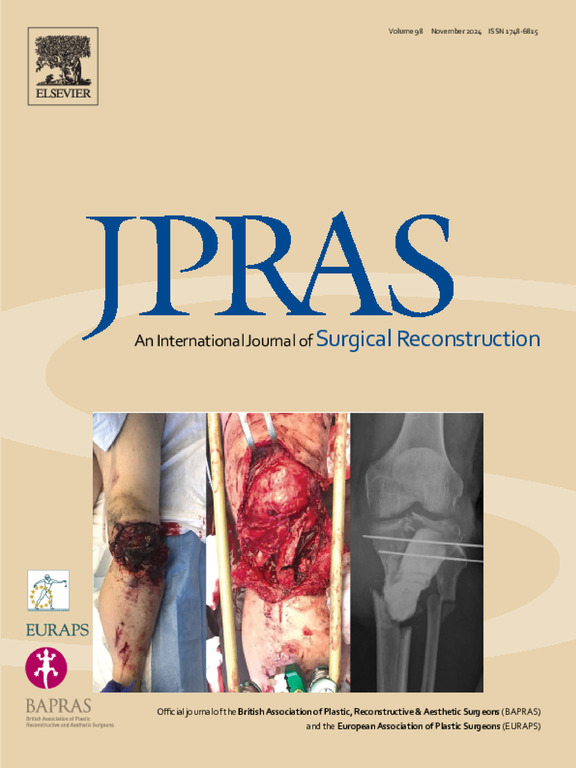Single modality indocyanine green is feasible for sentinel node detection in head and neck cutaneous melanoma: A prospective cohort study
IF 2
3区 医学
Q2 SURGERY
Journal of Plastic Reconstructive and Aesthetic Surgery
Pub Date : 2025-05-09
DOI:10.1016/j.bjps.2025.05.002
引用次数: 0
Abstract
Dual modality sentinel lymph node biopsy (SLNB) techniques are most commonly used in melanoma surgery, based on radiocolloid lymphoscintigraphy with either blue dye or indocyanine green (ICG) dye. No studies to date have analysed the use of ICG alone. This study examined the feasibility of ICG as a single modality for detecting sentinel nodes in cutaneous head and neck melanomas. A prospective cohort study was performed of all consecutive cutaneous head and neck melanomas patients between July 2023 and November 2024 undergoing SLNB at a supraregional skin cancer centre in the U.K. Three cohorts were formed: group A (ICG-only); group B (ICG and radiocolloid); and group C (radiocolloid and blue dye). 182 nodes were obtained from 67 patients. Where each technique was utilised, 100% of nodes were detected by ICG; 85% by radiocolloid; and 80% by blue dye. Radiocolloid failed to detect any nodes in three patients, and blue dye failed in four patients. In group B, ICG detected significantly more nodes than radiocolloid (p=0.0004); in group C, there was no difference between radiocolloid and blue dye (p=0.149). Twelve sentinel nodes were positive for melanoma: 100% were ICG positive, 88.9% were radiocolloid positive and 50% were blue dye positive. Single modality ICG is a feasible technique, with nodal detection and metastases detection rates comparable to dual modality. As an intraoperative surgeon-led technique, ICG-alone negates the need for preoperative lymphoscintigraphy with its associated radiation risk and nuclear medicine resource requirements.
单模态吲哚菁绿用于头颈部皮肤黑色素瘤前哨淋巴结检测是可行的:一项前瞻性队列研究
双模式前哨淋巴结活检(SLNB)技术最常用于黑色素瘤手术,基于放射性胶体淋巴显像,用蓝色染料或吲哚菁绿(ICG)染料。迄今为止,还没有研究单独分析ICG的使用情况。本研究探讨了ICG作为检测皮肤头颈部黑色素瘤前哨淋巴结的单一模式的可行性。一项前瞻性队列研究对2023年7月至2024年11月在英国一家跨区域皮肤癌中心接受SLNB治疗的所有连续皮肤头颈部黑色素瘤患者进行了前瞻性队列研究,分为三个队列:A组(仅icg);B组(ICG和放射性胶体);C组(放射性胶体和蓝色染料)。67例患者共切除182个淋巴结。在使用每种技术时,ICG检测到100%的节点;85%为放射性胶体;80%是蓝色染料。放射胶体在3例患者中未检测到任何淋巴结,蓝色染料在4例患者中未检测到任何淋巴结。B组ICG检测到的淋巴结明显多于放射性胶体(p=0.0004);C组放射性胶体与蓝色染料无显著性差异(p=0.149)。12个前哨淋巴结黑色素瘤阳性:ICG阳性100%,放射性胶体阳性88.9%,蓝染阳性50%。单模态ICG是一种可行的技术,其淋巴结检出率和转移检出率与双模态相当。作为一种术中外科引导的技术,单独的icg消除了术前淋巴显像的需要,其相关的辐射风险和核医学资源需求。
本文章由计算机程序翻译,如有差异,请以英文原文为准。
求助全文
约1分钟内获得全文
求助全文
来源期刊
CiteScore
3.10
自引率
11.10%
发文量
578
审稿时长
3.5 months
期刊介绍:
JPRAS An International Journal of Surgical Reconstruction is one of the world''s leading international journals, covering all the reconstructive and aesthetic aspects of plastic surgery.
The journal presents the latest surgical procedures with audit and outcome studies of new and established techniques in plastic surgery including: cleft lip and palate and other heads and neck surgery, hand surgery, lower limb trauma, burns, skin cancer, breast surgery and aesthetic surgery.

 求助内容:
求助内容: 应助结果提醒方式:
应助结果提醒方式:


